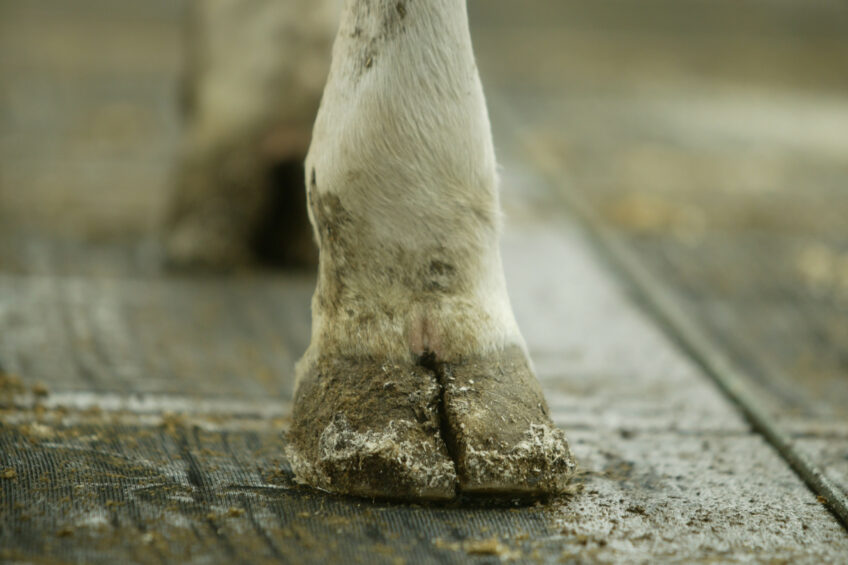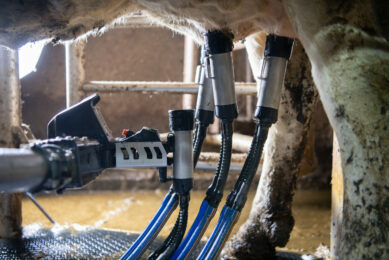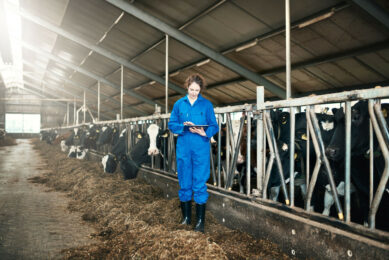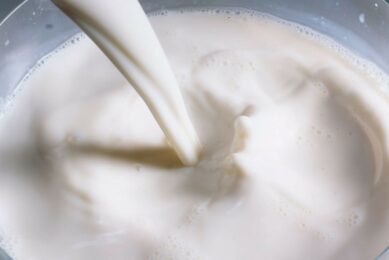Lameness management when using AMS

When using an automatic milking system, farmers are more challenged to maintain cow health and to prevent lameness. This is because lame cows in these automated systems produce less milk in fewer milkings per day.
The interest in installing an automatic milking system (AMS) is growing on dairy farms around the world (see box). In addition to reduced labour costs and greater time flexibility, producers can manage supplemental feed for each cow and the permission for cows to access the AMS for milking and a feed reward. But cows also have to get used to this new type of milking. Milking activity must now be encouraged through optimal management of nutrition, cow health, welfare, and behaviour, which also affect the willingness and ability of cows to visit the AMS.

Lame cows cannot be milked
This is especially the case for lameness. Producers strongly agree that lameness is a painful condition and they are willing to implement proven control measures, even if they are inconvenient; however, they still greatly underestimate the prevalence of lameness in their herd. Minimising lameness when using AMS is crucial because of the (ideally) voluntary component of milking activity. In other words, cows have to be fit enough and not lame to be able to reach the AMS by themsleves. In a PhD thesis at the University of Guelph in Canada the relationship between lameness and health disorders in cows milked in automated systems was further studied.
41 dairy farms studied
In the Canadian study, 41 commercial dairy farms with AMS (26 herds in Ontario and 15 herds in Alberta) were visited twice to collect data such as cow behaviour, locomotion and body condition score. Study herds milked 105 ± 56 lactating cows with 2.2 ± 1.3 AMS units and over 80% of herds used free cow traffic. Visits to the AMS for milking and related production parameters were automatically recorded by the AMS computer system of each farm. Rumination behaviour, activity data, standing and lying behaviour were collected by automated data loggers attached to each cow. In turn, comparisons of behaviour and productivity were made between lame (29% of the cows) and non-lame cows (71% of the cows).

Less milk and more often fetched
Lameness had a detrimental impact on the majority of outcome variables analysed, particularly parameters related to milk production and AMS visits. The data showed that lame cows produce 1.6 kilos of milk per day less and the average number of milkings was 0.3 per day lower. In addition, lame cows require more fetching (>1 x) in AMS, hence more labour time for the farmer. Of the lame cows, 15.3% were fetched >1x, 6.3% were fetched 1x, and 78.4% not at all during the 6-d data collection period. In contrast, 8.2, 6.2, and 85.6% of non-lame cows were fetched at those frequencies, respectively. As expected, lame cows spent more time lying down each day in longer bouts, which tended to be more frequent than non-lame cows. These findings are comparable to recent studies of conventional and AMS milked cows. Lameness was not associated with daily rumination time, night:day rumination ratio, or daily activity. Lame individuals did, however, have greater night:day activity ratios.
Global use of automatic milking Rapid adoption of automated (robotic) milking systems (AMS) has been occurring worldwide. As of 2014, over 25,000 farms globally were using AMS and this number continues to grow. In the United States and Canada the popularity of automatic milking systems is increasing rapidly. The most important reasons for this growth is that AMS frees up time for the dairy farmers to focus on other things around the farm (health management, administration) and to be less dependent on the use of external staff. In addition, with AMS, farms have the possibility to expand quicker without adding extra staff. Also in Western Europe, the use of AMS is growing. Based on a survey by Dutch magazine Melkvee100Plus, the percentage of dairy farms in the Netherlands that has a AMS is around 23% (more than 4,000 farms). In Sweden, AMR is present at almost 30% of the dairy farms. Norway sits higher with 45%. Countries that are a bit behind in the application of AMS are Germany (7%), Switzerland (20%), Austria (20%), France (10%), UK (7% and Ireland (3%). |
Prevention is key
This study compared individual lame and non-lame cows in automated milking systems and provides detailed estimates of the differences in behaviour and productivity associated with lameness. Cow-level risk factors identified for lameness in AMS were lower body condition, higher parity, and lower environmental temperature. While not directly associated with lameness in this study, greater stocking densities (at the AMS and relative to lying stalls) were associated with reduced lying time, increased daily activity, and an increased need to fetch cows for milking. The study further addresses that preventing lameness is key. Aside from genetic selection decisions, the only cow level factors which producers can manage are body condition and previous lameness, by detecting and treating lame cows earlier. Parity, combined with body size relative to stall width also influences the prevalence of lameness. It is therefore important to ensure stall comfort and adequate body condition for all cows in AMS herds.
Detection models and bedding
Also several lameness detection models have been developed or are being researched. These models take into account several data, such as activity, milk flow, milk yield per day, rumination data, lying time and body weight. Several models have been created that all use their own specific mix of data. On a herd level, dairy farmers should be aware of the proper use of footbaths (where to place them and how often do the cows use them?), stall design and availability of lying stalls, as they all can have an effect on hoof health. For example, earlier research showed that sand bedding can reduce lameness and increase milk production by approximately 10%, compared to non-sand surfaces and mattresses. This is because lame cows were also better able to perform natural lying behaviour in deep-bedded sand stalls.
This article is based, and a summary, of the report / PhD ‘Lameness and Health Disorders in Cows Milked in Automated Systems’, by Meagan Tatiana Madlung King, A Thesis presented to The University of Guelph (August 2017).
Join 13,000+ subscribers
Subscribe to our newsletter to stay updated about all the need-to-know content in the dairy sector, two times a week.










